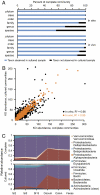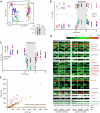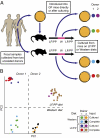Extensive personal human gut microbiota culture collections characterized and manipulated in gnotobiotic mice
- PMID: 21436049
- PMCID: PMC3076821
- DOI: 10.1073/pnas.1102938108
Extensive personal human gut microbiota culture collections characterized and manipulated in gnotobiotic mice
Abstract
The proportion of the human gut bacterial community that is recalcitrant to culture remains poorly defined. In this report, we combine high-throughput anaerobic culturing techniques with gnotobiotic animal husbandry and metagenomics to show that the human fecal microbiota consists largely of taxa and predicted functions that are represented in its readily cultured members. When transplanted into gnotobiotic mice, complete and cultured communities exhibit similar colonization dynamics, biogeographical distribution, and responses to dietary perturbations. Moreover, gnotobiotic mice can be used to shape these personalized culture collections to enrich for taxa suited to specific diets. We also demonstrate that thousands of isolates from a single donor can be clonally archived and taxonomically mapped in multiwell format to create personalized microbiota collections. Retrieving components of a microbiota that have coexisted in single donors who have physiologic or disease phenotypes of interest and reuniting them in various combinations in gnotobiotic mice should facilitate preclinical studies designed to determine the degree to which tractable bacterial taxa are able to transmit donor traits or influence host biology.
Conflict of interest statement
The authors declare no conflict of interest.
Figures




Comment in
-
Microbiome: Human gut microbiota can be readily cultured, manipulated and archived.Nat Rev Gastroenterol Hepatol. 2011 May 4;8(5):241. doi: 10.1038/nrgastro.2011.60. Nat Rev Gastroenterol Hepatol. 2011. PMID: 21701447 No abstract available.
References
-
- Razumov AS. Mikrobiologija. 1932;1:131–146.
Publication types
MeSH terms
Grants and funding
- P01 DK078669/DK/NIDDK NIH HHS/United States
- R01 DK030292/DK/NIDDK NIH HHS/United States
- R01 DK070977/DK/NIDDK NIH HHS/United States
- K01DK089121/DK/NIDDK NIH HHS/United States
- DK30292/DK/NIDDK NIH HHS/United States
- F32AI078628/AI/NIAID NIH HHS/United States
- F32 AI078628/AI/NIAID NIH HHS/United States
- DK70977/DK/NIDDK NIH HHS/United States
- T32-HD043010/HD/NICHD NIH HHS/United States
- R37 DK030292/DK/NIDDK NIH HHS/United States
- K01 DK089121/DK/NIDDK NIH HHS/United States
- T32 HD043010/HD/NICHD NIH HHS/United States
- DK78669/DK/NIDDK NIH HHS/United States
LinkOut - more resources
Full Text Sources
Other Literature Sources
Medical

